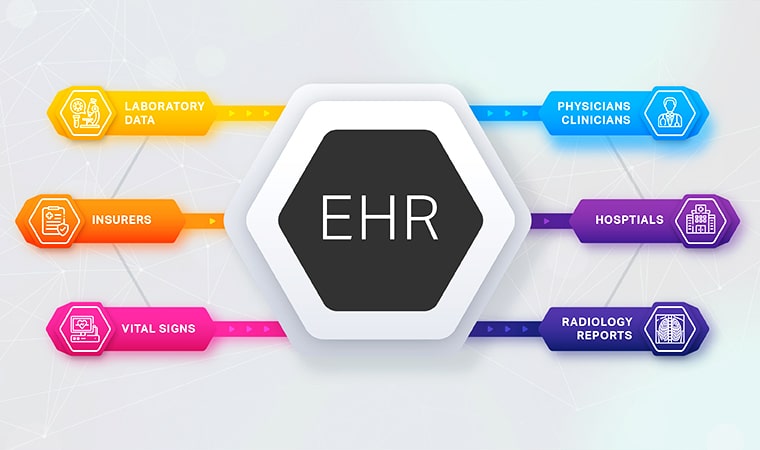Imagine a scenario where researchers are developing a new drug. They need extensive patient data for testing, but there are significant concerns about privacy and data availability.
Here, synthetic data offers a solution. It provides realistic yet entirely artificial datasets that mimic the statistical properties of real patient data. This approach enables comprehensive research without compromising patient confidentiality.
Donald Rubin pioneered the concept of synthetic data in the early 90s. He generated an anonymous dataset of U.S. census responses, mirroring the statistical properties of the actual Census data. This marked the creation of one of the first synthetic datasets that aligns closely with real census population statistics.
The application of synthetic data is rapidly gaining momentum. Accenture recognizes it as a key trend in the Life Sciences and MedTech. Similarly, Gartner forecasts that by 2024, synthetic data will constitute 60% of data usage.
In this article, we’ll talk about synthetic data in healthcare. We’ll explore its definition, how it’s generated, and its possible applications.
What is Synthetic data in healthcare?
Original Data:
Patient ID: 987654321
Age: 35
Gender: Male
Race: White
Ethnicity: Hispanic
Medical history: Hypertension, diabetes
Current medications: Lisinopril, metformin
Lab results: Blood pressure 140/90 mmHg, blood sugar 200 mg/dL
Diagnosis: Type 2 diabetes
Synthetic Data:
Patient ID: 123456789
Age: 38
Gender: Female
Race: Black
Ethnicity: Non-Hispanic
Medical history: Asthma, depression
Current medications: Albuterol, fluoxetine
Lab results: Blood pressure 120/80 mmHg, blood sugar 100 mg/dL
Diagnosis: Asthma
Synthetic data in healthcare refers to artificially generated data that simulate real patient health data. This type of data is created using algorithms and statistical models. It is designed to reflect the complex patterns and characteristics of actual healthcare data. Yet, it does not correspond to any real individuals, thereby protecting patient privacy.
The creation of synthetic data involves analyzing real patient datasets to understand their statistical properties. Then, using these insights, new data points are generated. These mimic the original data’s statistical behavior but do not replicate any individual’s specific information.
Synthetic data is becoming increasingly important in healthcare. It balances leveraging big data’s power and respecting patient confidentiality.
Current State of Data in Healthcare
Healthcare continually grapples with balancing data benefits against patient privacy concerns. Obtaining healthcare data for commercial or academic purposes is notably challenging and costly.
For example, gaining approval to use health system data can take up to two years. Accessing patient-level data often incurs costs in the hundreds of thousands, if not more, depending on the project’s scale. These obstacles significantly hinder progress in the field.
The healthcare sector is in the early stages of data sophistication and application. Several factors, including privacy concerns, the absence of standardized data formats, and the existence of data silos, have impeded innovation and advancement. However, this scenario is changing quickly, particularly with the rise of generative AI technologies.
Despite these hurdles, the use of data in healthcare is increasing. Platforms like Snowflake and AWS are in a race to offer tools that leverage this data’s potential. The growth of cloud computing is facilitating more advanced data analytics and accelerating product development.
In this context, synthetic data emerges as a promising solution to the challenges of data accessibility in healthcare.
How is Synthetic Data Used in Healthcare?
Synthetic data is the present-day revolution in healthcare, allowing organizations to innovate while being respectful of boundaries set by safety and privacy. Because they resemble real-world data, synthetic datasets enable researchers, clinicians, and developers to push for innovations unhindered by patient confidentiality.
Here are just a few simple real-world cases of how synthetic data is transforming healthcare:
1. Testing New Treatments Without Risking Privacy
Imagine a team of researchers developing a treatment for diabetes. Rather than accessing confidential patient records, they use synthetic data that mimics the traits of real patients, like age, blood sugar levels, and medical history. They get to develop hypotheses and refine them into protocols on how to tailor treatments while still preserving patient confidentiality.
2. Training AI for Faster Diagnoses
Think of a machine learning tool designed to detect lung cancer from X-rays. Synthetic medical images could include many scenarios—arraying tumor shapes, sizes, and locations in whatever fun way could help the machine learn accurately in identifying a case with mercurial relapse of cancer. This facilitates diagnosis while wholly circumventing ethical concerns around using actual patient scans.
3. Practicing Surgeries in Virtual Reality
Many medical students require real hands-on practice before they can treat real patients. Synthetic data creates a whole interactive transpose wherein a data-based virtual patient gets simulated with varied medical histories and conditions, thus letting students experience surgeries or diagnostic procedures repeatedly and very safely.
4. Enabling Public Health Planning
Simulating the course of diseases like COVID-19 or influenza with synthetic data is important for allowing epicenter researchers to model the epidemic spread of a virus through urban areas versus rural areas while estimating and testing vaccination strategies, thus circumventing the ignorance of sensitive population data.
5. Testing Medical Devices Safely
Consider a company developing a new wearable device to monitor heart rates. Synthetic datasets mimicking a variety of cardiopathies allow firms to test their devices under multiple scenarios before entering the economy.
How Synthetic Data Should Be Created for Healthcare
Creating synthetic data in healthcare is indeed a lengthy process drawing a fine line between technical expertise and a solid grasp of healthcare systems. To simplify the concepts, this is generally how synthetic data creation in healthcare settings can be construed.
1. Understand the Real Data
Health organizations examine real patient data beginning with hospital records, lab results, or the details of clinical trials. For example, a hospital might analyze its patient demographics, treatment history, and outcomes to achieve some insight into the underlying trends or patterns.
2. Stopping Patient Data Exposure by Removing PII
After that, for the sake of privacy, the dataset no longer contains personally identifiable information (PII)-names, addresses, or Social Security numbers. You may relate this to the process of anonymizing some medical notes, which, if printed now, will not be traceable to an individual.
3. Key Patterns Identification
A data scientist pours over a cleaned data set and discovers the patterns and interrelationships constituting yet another major building block for successful research. For instance, they might find that certain medications are used commonly by older adults with diabetes or that certain age groups tend to present with certain symptoms.
4. Building Models Using the Patterns
Once these patterns have been determined, the insights allow the construction of mathematical models that emulate the statistical associations found in the real data. For example, if 30% of patients in the data set have high blood pressure, we can guess that the synthetic data will roughly reflect these conditions in similar proportions.
6. Validating the Synthetic Data
Then the synthetic dataset is compared against the original data so that it retains the same statistics defining the properties and relationships. For example, if there is a dependent correlation between obesity and heart disease in the original data set, the same should exist for this synthetic dataset.
7. Real-World Usage Testing
Finally, the synthetic data is taken out for testing in various scenarios to make a claim that it can be used for its then-intended purposes. These include using it to allow researchers to train an AI model for diagnosing diseases or simulating operational resource variations in the emergency department associated with the flu season.
How to Validate Synthetic Data for Healthcare
Decision-makers in organizations must scrutinize the validity of synthetic data prior to its application in healthcare. This paradigm applies to any and all data used under confidentiality protocols. The following are ways to assess the validity of synthetic data:
- Comparison with Real Data: Synthetic data is compared to real data to confirm that the major trends it defines, e.g., the relationship between age and disease, are properly mirrored. For example, if 20 percent of real patients have diabetes, then a similar proportion should manifest in synthetic patients.
- Conducting Statistical Tests: Statistical tests allow us to test if the synthetic data is in line with the original in terms of distributions and correlation, thus confirming that it is reasonable and trustworthy for analysis.
- Validation on Real Tasks: The real-world tasks such as the training exercise on AI models would be used to compare whether the results obtained from training synthetic data would also produce an outcome similar to training on real data.
- Expert Review: Synthetic datasets are reviewed for authentic attributes by clinicians and healthcare experts, such as standard histories and treatments to be met by a realistic research study.
- Privacy Controls in Place: This assessment will make sure that synthetic data cannot be traced back to real patients and will keep the privacy of real patients intact while avoiding the loss of usability of the dataset.
Synthetic Data’s Potential in Healthcare and Pharmaceuticals

Integrating synthetic data in healthcare and pharmaceuticals opens up a world of possibilities. This innovative approach is reshaping various aspects of the industry. Synthetic data’s ability to mirror real-world datasets while maintaining privacy is revolutionizing multiple sectors.
Enhance Data Accessibility While Upholding Privacy
One of the most significant hurdles in healthcare and pharma is accessing vast data while adhering to privacy laws. Synthetic data offers a groundbreaking solution. It provides datasets that retain the statistical characteristics of real data without exposing private information. This advancement allows for more extensive research and training of machine learning models. It fosters advancements in treatment and drug development.
Better Patient Care through Predictive Analytics
Synthetic data can vastly improve patient care. Machine learning models trained on synthetic data help healthcare professionals predict patient responses to treatments. This advancement leads to more personalized and effective care strategies. Precision medicine becomes more achievable to enhance treatment efficacy and patient outcomes.
Streamline Costs with Advanced Data Utilization
Applying synthetic data in healthcare and pharmaceuticals also leads to significant cost reductions. It minimizes the risks and costs associated with data breaches. Additionally, the improved predictive capabilities of machine learning models help optimize resources. This efficiency translates into reduced healthcare costs and more streamlined operations.
Testing and Validation
Synthetic data enables the safe and practical testing of new technologies, including electronic health record systems and diagnostic tools. Healthcare providers can rigorously evaluate innovations using synthetic data without risking patient privacy or data security. It ensures that new solutions are efficient and reliable before they are implemented in real-world scenarios.
Foster Collaborative Innovations in Healthcare
Synthetic data opens new doors for collaboration in healthcare and pharmaceutical research. Organizations can share synthetic datasets with partners. It enables joint studies without compromising patient privacy. This approach paves the way for innovative partnerships. These collaborations accelerate medical breakthroughs and create a more dynamic research environment.
Challenges with Synthetic Data
While synthetic data holds immense potential, it also has challenges you must address.
Ensuring Data Accuracy and Representativeness
The synthetic datasets must closely mirror the real-world data's statistical properties. However, achieving this level of accuracy is complex and often requires sophisticated algorithms. It may lead to misleading insights and false conclusions if not done correctly.
Managing Data Bias and Diversity
Since synthetic datasets are generated based on existing data, any inherent biases in the original data may be replicated. Ensuring diversity and eliminating biases is crucial to make the synthetic data reliable and universally applicable.
Balancing Privacy and Utility
While synthetic data is praised for its ability to protect privacy, striking the right balance between data privacy and utility is a delicate task. There's a need to ensure that the synthetic data, while anonymized, retains enough detail and specificity for meaningful analysis.
Ethical and Legal Considerations
Questions about consent and the ethical use of synthetic data, especially when derived from sensitive health information, remain areas of active discussion and regulation.
Privacy and security with Synthetic data in Healthcare
While synthetic data is known to protect patient privacy through the substation of real data with an artificial-though realistic alternative, privacy, and security dilemmas are still aplenty. One of the primary risks associated is reidentification whereby synthetic data inadvertently exposes patterning that could help decipher real patients under study. Compliance with rules and regulations puts an additional level of obstacle to mitigating such issues- considerations while working with synthetic data: HIPAA and GDPR.
To remedy these concerns, healthcare organizations must adopt more robust privacy-preserving techniques-such as differential privacy and secure algorithms- to prevent such utilization. If such evolving and complex risk managers are put into preventive measures, synthetic data will continue to innovate while respecting any principles of confidentiality around the patient and common sense of ethicality.
Conclusion
Synthetic data is transforming healthcare and pharmaceuticals by balancing privacy with practical use. Although it faces challenges, its ability to improve research, patient care, and collaboration is significant. This makes synthetic data a key innovation for the future of healthcare.







